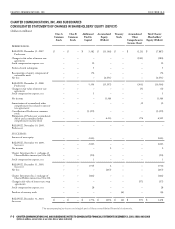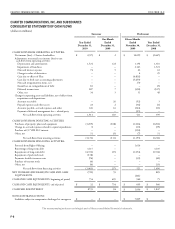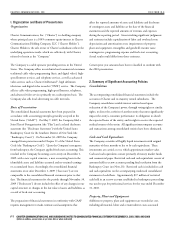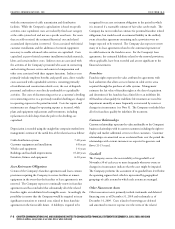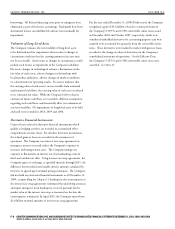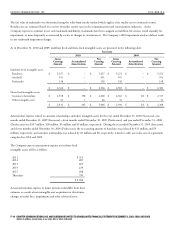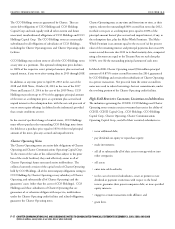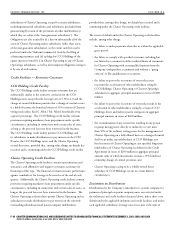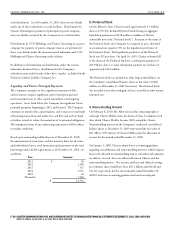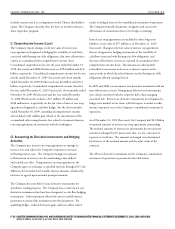Charter 2010 Annual Report Download - page 98
Download and view the complete annual report
Please find page 98 of the 2010 Charter annual report below. You can navigate through the pages in the report by either clicking on the pages listed below, or by using the keyword search tool below to find specific information within the annual report.
F- F-PB
CHARTER COMMUNICATIONS, INC. AND SUBSIDIARIES NOTES TO CONSOLIDATED FINANCIAL STATEMENTS DECEMBER 31, 2010, 2009, AND 2008
(dollars in millions, except share or per share data or where indicated)
e Company recorded non-cash franchise impairment charges of $2.2
billion and $1.5 billion for the eleven months ended November 30,
2009 (Predecessor) and year ended December 31, 2008 (Predecessor),
respectively. e impairment charges recorded in 2009 and 2008
were primarily the result of the impact of the economic downturn
along with increased competition. e Company’s 2010 impairment
analyses did not result in any franchise impairment charges.
On the Effective Date, the Company applied fresh start accounting
and adjusted its franchise, goodwill, and other intangible assets
including trademarks and customer relationships to reflect fair value.
e Company’s valuations, which are based on the present value of
projected after tax cash flows, resulted in a value for property, plant
and equipment, franchises, and customer relationships for each unit
of accounting. As a result of applying fresh start accounting, the
Company recorded goodwill of $951 million which represents the
excess of reorganization value over amounts assigned to the other assets.
Franchises, for valuation purposes, are defined as the future economic
benefits of the right to solicit and service potential customers
(customer marketing rights), and the right to deploy and market
new services, such as Internet and telephone, to potential customers
(service marketing rights). Fair value is determined based on
estimated discrete discounted future cash flows using assumptions
consistent with internal forecasts. e franchise after-tax cash flow
is calculated as the after-tax cash flow generated by the potential
customers obtained (less the anticipated customer churn), and the
new services added to those customers in future periods. e sum
of the present value of the franchises' after-tax cash flow in years
1 through 10 and the continuing value of the after-tax cash flow
beyond year 10 yields the fair value of the franchises.
e Company determined the estimated fair value of each unit
of accounting utilizing an income approach model based on the
present value of the estimated discrete future cash flows attributable
to each of the intangible assets identified for each unit assuming
a discount rate. is approach makes use of unobservable factors
such as projected revenues, expenses, capital expenditures, and a
discount rate applied to the estimated cash flows. e determination
of the discount rate was based on a weighted average cost of capital
approach, which uses a market participant’s cost of equity and after-
tax cost of debt and reflects the risks inherent in the cash flows.
e Company estimated discounted future cash flows using
reasonable and appropriate assumptions including among others,
penetration rates for basic and digital video, high-speed Internet,
and telephone; revenue growth rates; operating margins; and
capital expenditures. e assumptions are derived based on the
Company’s and its peers’ historical operating performance adjusted
for current and expected competitive and economic factors
surrounding the cable industry. e estimates and assumptions made
in the Company’s valuations are inherently subject to significant
uncertainties, many of which are beyond its control, and there is no
assurance that these results can be achieved. e primary assumptions
for which there is a reasonable possibility of the occurrence of a
variation that would significantly affect the measurement value
include the assumptions regarding revenue growth, programming
expense growth rates, the amount and timing of capital expenditures
and the discount rate utilized.
Goodwill is tested for impairment as of November 30 of each year, or
more frequently as warranted by events or changes in circumstances.
e first step involves a comparison of the estimated fair value of
each of our reporting units to its carrying amount. If the estimated
fair value of a reporting unit exceeds its carrying amount, goodwill of
the reporting unit is not considered impaired and the second step of
the goodwill impairment is not necessary. If the carrying amount of a
reporting unit exceeds its estimated fair value, then the second step of
the goodwill impairment test must be performed, and a comparison
of the implied fair value of the reporting unit’s goodwill is compared
to its carrying amount to determine the amount of impairment, if any.
Reporting units are consistent with the units of accounting used for
franchise impairment testing. Likewise the fair values of the reporting
units are determined using a consistent income approach model as that
used for franchise impairment testing. e Company’s 2010 impairment
analyses did not result in any goodwill impairment charges.
Customer relationships, for valuation purposes, represent the value of
the business relationship with existing customers (less the anticipated
customer churn), and are calculated by projecting the discrete
future after-tax cash flows from these customers, including the right
to deploy and market additional services to these customers. e
present value of these after-tax cash flows yields the fair value of the
customer relationships. Customer relationships are amortized on
an accelerated method over useful lives of 11-15 years based on the
period over which current customers are expected to generate cash
flows. Customer relationships are evaluated upon the occurrence
of events or changes in circumstances indicating that the carrying
amount of an asset may not be recoverable.




